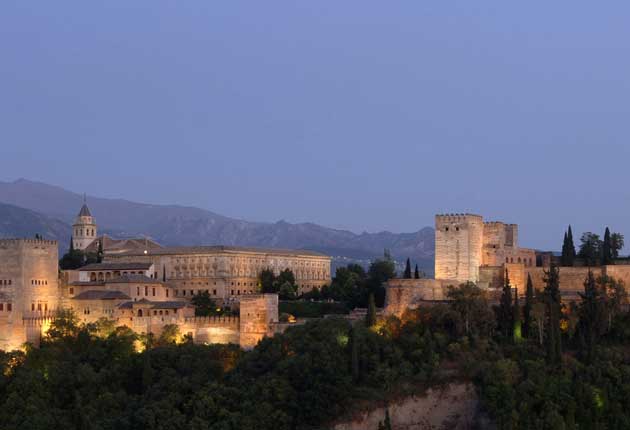After 650 years, the wisdom of the Alhambra is revealed
Granada's fortress-palace built by Spain's medieval Moorish rulers, has always fascinated visitors. But what messages do its intricately carved walls hold – poetry, philosophy or piety? Elizabeth Nash reports

Your support helps us to tell the story
From reproductive rights to climate change to Big Tech, The Independent is on the ground when the story is developing. Whether it's investigating the financials of Elon Musk's pro-Trump PAC or producing our latest documentary, 'The A Word', which shines a light on the American women fighting for reproductive rights, we know how important it is to parse out the facts from the messaging.
At such a critical moment in US history, we need reporters on the ground. Your donation allows us to keep sending journalists to speak to both sides of the story.
The Independent is trusted by Americans across the entire political spectrum. And unlike many other quality news outlets, we choose not to lock Americans out of our reporting and analysis with paywalls. We believe quality journalism should be available to everyone, paid for by those who can afford it.
Your support makes all the difference.Visitors to the Alhambra fortress-palace in Granada have for centuries fallen into a reverie before its intricately carved medieval walls, wondering at the meaning of the Arabic inscriptions that adorn them from floor to ceiling. The script that winds round the filigree arches and pillared courtyards is so stylised that it's often difficult to disentangle words from images, and few can decipher the classical Arabic in which they are written.
Now, the carvings have been logged and translated, finally answering the question that has perplexed generations of visitors to Europe's jewel of Muslim architecture: "What are these walls telling me?"
Researchers have produced an interactive DVD that decodes, dates and identifies 3,116 of some 10,000 inscriptions carved on the building that symbolises centuries of Muslim rule in Spain and is today the country's top tourist landmark.
"There's perhaps nowhere else in the world where gazing upon walls, columns and fountains is an exercise so similar to turning the pages of a book of poems," says Juan Castilla, from the School of Arabic Studies at Spain's Higher Scientific Research Council, whose team produced this still-incomplete guide.
Arabic artisans, supervised by poets employed in the 14th-century court of King Yusuf I, drew up the decorative plans and planned the spaces where verses – original, or copied – were to be engraved.
So, what do these words say? "There aren't as many as we thought," Dr Castilla confessed. Inscriptions of poetry and verses from the Koran that have inspired generations represent only a minimum percentage of the texts that adorn the Alhambra's walls, despite the mistaken belief that they are smothered in writings of this kind, he said, presenting his study in Madrid.
Instead the motto of the Nazrid dynasty – "There is no victor but Allah" – is repeated hundreds of times on walls, arches and columns. Isolated words like "happiness" or "blessing" recur, seen as divine expressions protecting the monarch or governor honoured in each palace or courtyard. Aphorisms abound: "Rejoice in good fortune, because Allah helps you," and "Be sparse in words and you will go in peace."
Researchers built upon studies begun 500 years ago by the conquerors of the Nazrid dynasty, who ruled the kingdom of Al Andalus and created this fabulous pile. The Catholic monarchs Ferdinand and Isabella ruthlessly purged Muslims from Spain after 1492, but they were sufficiently curious about their vanquished enemy's heritage, or impressed by the Alhambra's unique beauty, to order specialist translators to study the inscriptions that cover every nook and cranny.
For centuries scholars spent half their life, and ruined their eyesight, scrutinising the messages embedded in the geometric tiles or finely carved in the stonework. Among them are verses by the acclaimed Islamic poets Ibn al-Khatib and Ibn Zamrak, some of which describe the place where they appear, such as the Hall of the Two Sisters, which represents a garden: "Moreover we do not know of any other garden/more pleasant in its freshness, more fragrant in its surroundings,/or sweeter in the gathering of its fruits..." wrote Ibn Zamrak.
The ceiling represented heaven: "The hands of the Pleiades will spend the night invoking/God's protection in their favour and they will awaken to/the gentle blowing of the breeze./ In here is a cupola which by its height becomes lost from/sight..." the poet wrote.
Until now, however, efforts to transcribe such verses have revealed only a fraction of the material. With modern technology, including a 3D laser scanner, "we have achieved not so much a discovery as an exhaustive labour that seeks to register all the inscriptions," said Dr Castilla. At the touch of a mouse, everyone from the specialist to the idly curious can now learn the meaning of the ancient words, see exactly where they are located, and how often they are repeated on the walls.
The form of script is also described: angular kufic, whose uprights sprout into decorative foliage, or intertwine; curlicue cursive; or a mixture of forms. In a culture that banned human images, the form as well as the content of the calligraphy was designed to exalt temporal and heavenly rulers.
Kufic is used for quotations from the Koran, which tend to be high up on the walls, while the poetry is nearer the ground – further from heaven, scholars say – in elaborately cursive script.
The DVD takes you on a virtual tour of all the writings, with details (in Spanish only, so far) of when and how each was created. This first volume covers the citadel-palace of Comares. The Palace of Lions, with its renowned courtyard and fountain, follows later this year. The guide is due to be completed, and reissued in one compilation DVD by 2010.
Join our commenting forum
Join thought-provoking conversations, follow other Independent readers and see their replies
Comments